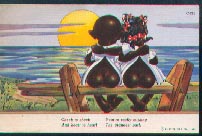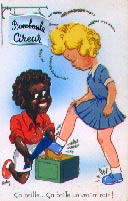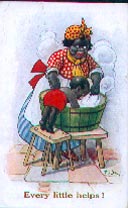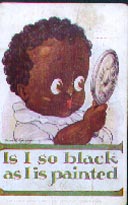BLACK EPHEMERA
It seems that history has a funny habit of repeating itself
and often reinventing cultural and historical experiences
as a new perspective or contribution to modernity. The global
history of black people living in western societies, Africa,
Caribbean and South America is no exception to the rule.
 There is a strong link in the development of mass communication,
particularly, growth of the postcard industry between 1870-1940s
and the diffusion of negative racist and stereotypes images.
These beliefs and attitudes reflected in cards were based
by colonial expats based in Africa (teachers, administrators,
soldiers, missionaries, entrepreneurs, explorers, and anthropologists)
and the legacy of slavery and plantation societies in North
America, Caribbean and South America. There is a strong link in the development of mass communication,
particularly, growth of the postcard industry between 1870-1940s
and the diffusion of negative racist and stereotypes images.
These beliefs and attitudes reflected in cards were based
by colonial expats based in Africa (teachers, administrators,
soldiers, missionaries, entrepreneurs, explorers, and anthropologists)
and the legacy of slavery and plantation societies in North
America, Caribbean and South America.
Racist assumptions were based on the following beliefs and
values about the role of black people from the 18th and 19th
Century:
- Black people were born to be in servitude (curse of Ham
in the bible which was adopted to justify slavery on religious
grounds);
- Racial science based evolutionary/eugenics theories (e.g.
Darwin) that black people have not achieved full development
as human beings and thus low intelligence and but have
a capacity for physical labour and child like naivete
in making
fun entertainment;
- Enlightenment school of philosophy (e.g.Locke, Hegel)
black people have not made any significant contribution
to world history and mankind and thus they can only relate
to a primitive/savage existence.
The growth and development of the Post Card industry between
1870-1940 laid the modern foundation of promulgation of racist
images into popular culture (newspapers and film &television
also played an important contribution).
Post cards were the equivalent of the email and the telephone
as way of communicating through the generation ideas, thoughts
and opinions.
Ephemera is the phrase used by collectors and dealers on
items and subject matters on paper e.g. postcards, newspapers,
trade/cigarette cards, posters, correspondence, documents,
advertisements etc
 The concept of the postcard was developed in Germany in the
1860s however; it was not until the 1870s with the introduction
of printing technology and the development of postage services
that cards were available to the public to use as a form of
communication. The growth of the industry was limited by regulations
imposed by various countries regarding size of cards and postage
rates. Nevertheless, after 1894 in USA and 1902 in UK these
restrictions were lifted (a number of European countries were
al ready advanced in this field). The concept of the postcard was developed in Germany in the
1860s however; it was not until the 1870s with the introduction
of printing technology and the development of postage services
that cards were available to the public to use as a form of
communication. The growth of the industry was limited by regulations
imposed by various countries regarding size of cards and postage
rates. Nevertheless, after 1894 in USA and 1902 in UK these
restrictions were lifted (a number of European countries were
al ready advanced in this field).
The above results laid the foundation of the industry in
USA and UK with the tremendous growth of picture postcards
manufacturers and publishers almost equivalent to the dotcom
expansion in the 1990s.
The industry was open to anyone start a business and used
their own images or pictures or commission artist and
photographers.
In Britain most cards were printed in Germany as the cost
were far cheaper for the new market
However, a number of companies dominated the industry with
high quality and vast range of images and products: Valentine&Sons,
Raphael Tuck&Sons, Detroit publishing,
1909 distributed over 860 million postcards every week in
the British postal system. By end of the first world war postcards
had achieved the status as a major mass communication vehicle
for companies to promote and advertise their products and
services; individuals to communicate in a personal way to
friends, family and work colleagues locally and around the
world (essential in a pre telephone age).
 In addition, postcards achieved the status as collector's
items where publishers printed millions of cards for individual
indulgence and pleasure. In addition, postcards achieved the status as collector's
items where publishers printed millions of cards for individual
indulgence and pleasure.
The categories varied in subject matter ranging from actresses,
rail disasters, churches, hospital wards, windmills, airships,
shop fronts, advertising&propaganda, risque'obscene, topographical.
Novelty cards were also popular publishers used there creative
ideas to (nearest comparison is the genre of reality TV programmes
such as Big Brother and Survivor) excite and push imaginations
of the public to new realms.
The depiction of black images in ephemera can be analysed
in the following categories:
1. Topological country scenes of Africa,Caribbean,South
America and Deep South of America (pictures and scenes of
famous landmarks
e.g. Victoria Falls (Zimbabwe), Pyramids (Egypt), Panama
Canal (Panama), Pitons (St Lucia)
2. Social history/life style(street/market scenes,people at
work e.g. picking cotton, fishing, hunting
3. Family/village life e.g. images of families (typically
chief and tribe members), warriors, children playing, people
outside huts/shanty towns
4. Celebration of Empires, Colonies and Reconstruction period
(USA) servitude of black surbodinates (pictures of Misionaries,
Colonial
administrators, Officers from armed forces, business men
giving orders, directions or posing as superior beings to
their black
subjects)
5. Coon/Buffoons (humorous images of black men and boys
as foolish/stupid/lazyand eating food like watermelons)
6. Children (images of either black child or black and white
children playing with captions that question the identity
of the black child)
7. Cleanliness (images of a mammy figure or a white child
using a soap product to scrub hard a black child with captions
referring
to identity)
8. Lynching and Beatings (pictures of black men being lynched
or being beating publicly as a spectators sport and family
outings)
9. Entertainers and Sports Personalities (pictures of Jack
Johnson, Josephine Baker, Samuel Coolridge Taylor and Kaffar
Boys)
10. Women (erotica images of black women)
 However it must be said that some of the images all so have
some positive perspective. The images gives an historical
dimension of the life of black communities around the world
after slavery and prior to the movement in Africa and the
Caribbean and the lifestyle of the first black people came
to Britain after WW2 and the Windrush. However it must be said that some of the images all so have
some positive perspective. The images gives an historical
dimension of the life of black communities around the world
after slavery and prior to the movement in Africa and the
Caribbean and the lifestyle of the first black people came
to Britain after WW2 and the Windrush.
All these assumptions and theories influenced popular culture
and the perception of black people internationally. Postcards
effectively diffused these perceptions in images to millions
of white people around the world particularly in Europe where
there was no or limited black population.
The historical process since the emancipation/abolition of
slavery and the creation of colonial/post colonial states
in Africa and the Caribbean along the development of multi
cultural societies in Europe and North America.
The mainstreaming and the institutionalization of racist
images, thoughts, perceptions and values which is currently
reflected in negative stereotypes of black people in popular
culture, science, medicine, media and the schooling and education
of all young people.
With the duty under the Race Relations Amendment Act 2001
it is important that we promote and develop positive images,
structures and challenge racist ideology in mainstream institutions
if we are to ensure the next generation of black people living
in Britain have respect and be value by society and ourselves.
 Black Ephemera is the forgotten and hidden history how black
people have been transformed from chattel labour/colonial
subjects to brands in popular culture and victims of mordenity
by society (health inequality, mental illness, school exclusion,
black and black violence e.g. domestic violence and gun crime). Black Ephemera is the forgotten and hidden history how black
people have been transformed from chattel labour/colonial
subjects to brands in popular culture and victims of mordenity
by society (health inequality, mental illness, school exclusion,
black and black violence e.g. domestic violence and gun crime).
Patrick Vernon
Currently undertaking a Ph.D. at Birkbeck College on the
life and writings of JA Rogers.
Some additional links of interest (Supplied
by BHM not the author):
Collecting
a Painful Past: Black Memorabilia (Canadian Site)
Antiques Roadshow (USA): Tips of the Trade: African Americana
Black
Memorabilia: Article by Ester Raye Deen (USA/UK) (No
longer available?)
Plenty
of resources available to collectors of black memorabilia by
Renee Kientz (Houston Chronicle Archives 2002)
PRIDE & prejudice / A complex and controversial area of collecting, black
memorabilia runs the gamut from racist to inspirational by
Renee Kientz (Houston Chronicle Archives 2002)
Objects for Sale (USA)
Ruby
Lane Antiques, Collectibles & Fine Art, category,
Black Americana - objects for sale (USA)
Tias.com:
Antiques: Black Memorabilia - objects for sale
(USA)
Judy
Posner Antiques: Black Americana - objects for sale
(USA)
Books (Mostly American)
Black
Memorabilia for the Kitchen by
Jan Lindenberger (2003). by
Jan Lindenberger (2003).
The
Art and History of Black Memorabilia: We Never Fade by
Larry V Buster (2000). "Black memorabilia is one of
the most provocative areas of collecting in America today,
encompassing anything made by or depicting people of African
descent. It includes a diverse range of objects and documents
that span five centuries of African-American life, from trade
cards to kitchen novelties; dolls and toys to sports and
civil-rights mementos; cereal boxes and product labels to
books and sheet music; and even the shackles, classified
ads, and bills of sale that document the long years of black
slavery. Often harsh and painful to examine, these artifacts
nonetheless offer an important window into American history.
They have become highly valued collectibles, and especially
so among African Americans. The Art and History of Black
Memorabilia, by Larry Vincent Buster, is the first fully
illustrated overview of this remarkable area of Americana.
With more than two hundred color photographs, this volume
examines the most desirable black collectibles and places
them within their historical and social contexts. The author,
himself a noted collector, includes information on how to
buy, display, and preserve black memorabilia and explains
how to spot fakes and reproductions. Also included are explorations
of some of the most well-known and influential African-American
figures in popular culture. At times horrifying yet sublime,
insulting yet intriguing, humorous, heartbreaking, and inspiring,
The Art and History of Black Memorabilia is a landmark chronicle
of the black experience in America." by
Larry V Buster (2000). "Black memorabilia is one of
the most provocative areas of collecting in America today,
encompassing anything made by or depicting people of African
descent. It includes a diverse range of objects and documents
that span five centuries of African-American life, from trade
cards to kitchen novelties; dolls and toys to sports and
civil-rights mementos; cereal boxes and product labels to
books and sheet music; and even the shackles, classified
ads, and bills of sale that document the long years of black
slavery. Often harsh and painful to examine, these artifacts
nonetheless offer an important window into American history.
They have become highly valued collectibles, and especially
so among African Americans. The Art and History of Black
Memorabilia, by Larry Vincent Buster, is the first fully
illustrated overview of this remarkable area of Americana.
With more than two hundred color photographs, this volume
examines the most desirable black collectibles and places
them within their historical and social contexts. The author,
himself a noted collector, includes information on how to
buy, display, and preserve black memorabilia and explains
how to spot fakes and reproductions. Also included are explorations
of some of the most well-known and influential African-American
figures in popular culture. At times horrifying yet sublime,
insulting yet intriguing, humorous, heartbreaking, and inspiring,
The Art and History of Black Memorabilia is a landmark chronicle
of the black experience in America."
Encyclopedia
of Black Collectibles, The: A Value and Identification Guide by
Dawn E. Reno (1996). "Black collectables form a record
of the African-American experience. This guide, designed
for enthusiasts in the field, contains over 1000 items and
ranges from slave documents and relics to black folk art
and advertising matter. Historical background information
is also featured." by
Dawn E. Reno (1996). "Black collectables form a record
of the African-American experience. This guide, designed
for enthusiasts in the field, contains over 1000 items and
ranges from slave documents and relics to black folk art
and advertising matter. Historical background information
is also featured."
Black
Memorabilia Around the House: A Handbook and Price Guide by
Jan Lindenberger (1996). by
Jan Lindenberger (1996).
Black
Americana Postcard Price Guide: A Century of History Preserved
on Postcards by
JL Mashburn (1995). by
JL Mashburn (1995).
Mammy
and Uncle Mose: Black Collectibles and American Stereotyping by
K W Goings (1994). "The objects, displayed in color
photos, are the antithesis of politically correct and shock
as thoroughly as do holocaust photos. Goings (History, Florida
Atlantic U.) grabs hold of a sabre-tooth'd dimension of popular
culture." by
K W Goings (1994). "The objects, displayed in color
photos, are the antithesis of politically correct and shock
as thoroughly as do holocaust photos. Goings (History, Florida
Atlantic U.) grabs hold of a sabre-tooth'd dimension of popular
culture."
Black
Dolls 1820-1991: An Identification and Value Guide by
Myla Perkins (1992). by
Myla Perkins (1992).
Images
in Black: 300 Years of Black Collectibles by
Douglas Congdon-Martin (1990). "This paperback is
a price guide written for a general audience and is especially
strong
in its coverage of older black memorabilia of higher value." by
Douglas Congdon-Martin (1990). "This paperback is
a price guide written for a general audience and is especially
strong
in its coverage of older black memorabilia of higher value."
Black
Collectibles Sold in America by
P.J. Gibbs (Hardcover 1986). "This hardcover is also
a price guide that is very strong in its coverage of more
modern black memorabilia, such as Black Panther buttons." by
P.J. Gibbs (Hardcover 1986). "This hardcover is also
a price guide that is very strong in its coverage of more
modern black memorabilia, such as Black Panther buttons."
The Art of Collecting Black Memorabilia by
Philip J. Merrill, currently out of print. "An explanation
of the process of collecting black memorabilia in this
helpful reference tool. Contact Philip at P.O. Box
21102, Baltimore, Maryland, USA."
|




